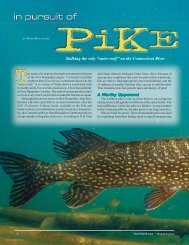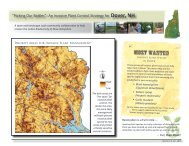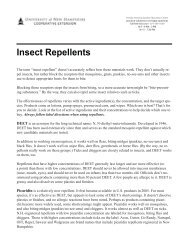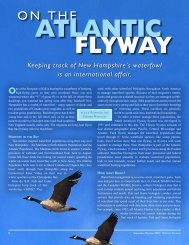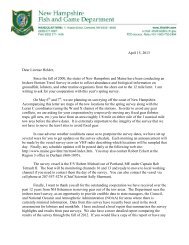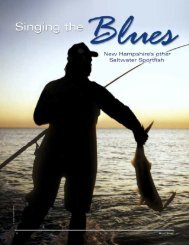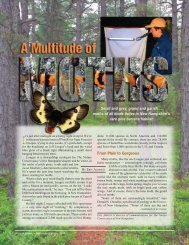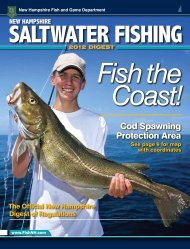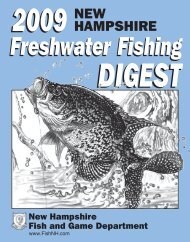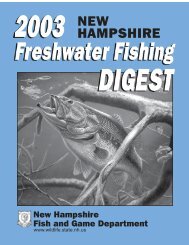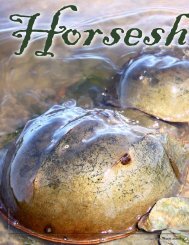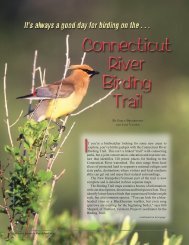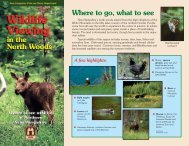A lifetime harvesting the resources of Great Bay - New Hampshire ...
A lifetime harvesting the resources of Great Bay - New Hampshire ...
A lifetime harvesting the resources of Great Bay - New Hampshire ...
Create successful ePaper yourself
Turn your PDF publications into a flip-book with our unique Google optimized e-Paper software.
In longstanding tradition,<br />
<strong>Bay</strong>men meet on<br />
<strong>the</strong> mud flats <strong>of</strong> <strong>Great</strong><br />
<strong>Bay</strong> on a September<br />
Saturday for <strong>the</strong> first<br />
day <strong>of</strong> clamming season.<br />
©David O’Hearn photo<br />
An engine chugs across<br />
<strong>the</strong> Stratham-<strong>New</strong>fields<br />
railroad trestle over <strong>the</strong><br />
Squamscott River near<br />
<strong>Great</strong> <strong>Bay</strong>.<br />
Previous page and<br />
below: Still stunning<br />
today, <strong>the</strong> expansive<br />
view <strong>of</strong> <strong>Great</strong> <strong>Bay</strong><br />
from <strong>the</strong> fire tower<br />
in Stratham Hill Park<br />
inspired <strong>the</strong> author as<br />
a boy.<br />
age, I had acquired a taste for s<strong>of</strong>tshell clams. There is<br />
a <strong>Bay</strong>man tradition that continues to this day – all <strong>the</strong><br />
“old salts” like to meet at <strong>the</strong> flats on <strong>the</strong> first day <strong>of</strong><br />
clamming each September. It is a good place to share<br />
a beverage and catch up on each o<strong>the</strong>r’s activities. The<br />
oyster tongers are <strong>the</strong>re too. If we’re lucky and <strong>the</strong><br />
water is clear, we can pick a couple gallons <strong>of</strong> oysters<br />
right <strong>of</strong>f <strong>the</strong> bottom. This is a day I look forward to<br />
each year.<br />
Lobstering<br />
Like any good tree with strong roots and a straight<br />
trunk, branches started to appear – my interest in <strong>the</strong><br />
bay deepened as I discovered new possibilities. Two<br />
<strong>of</strong> my good friends, Joe Daley and Mark Doll<strong>of</strong>f <strong>of</strong><br />
<strong>New</strong>fields, N.H., were trapping lobster in <strong>the</strong> <strong>Great</strong><br />
<strong>Bay</strong> estuary. After a couple adventures on <strong>the</strong>ir boat, I<br />
knew this was something I had to try.<br />
Who would have thought so far from <strong>the</strong> ocean we<br />
would have American lobster? The nursery <strong>of</strong> <strong>Great</strong><br />
<strong>Bay</strong> plays a special role for <strong>the</strong> lobster. Each spring,<br />
lobsters migrate from <strong>the</strong> ocean into <strong>Great</strong> <strong>Bay</strong> to<br />
shed or “molt” <strong>the</strong>ir shell. The lobsters come for <strong>the</strong><br />
mud that dominates <strong>the</strong> floor <strong>of</strong> <strong>the</strong> estuary. After a<br />
lobster sheds its shell, it is very vulnerable to predators.<br />
Lobsters use holes in <strong>the</strong> mud to hide in while<br />
<strong>the</strong>ir new shell hardens. <strong>Great</strong> <strong>Bay</strong> is a good place<br />
to see <strong>the</strong> difference between a hard shell (recently<br />
arrived from <strong>the</strong> ocean) and s<strong>of</strong>t shell (new shell<br />
hardening) lobster. A hard-shell <strong>Great</strong> <strong>Bay</strong> lobster is<br />
quite a delicacy.<br />
I started with five traps. Those five traps grew to<br />
ten, and <strong>the</strong>n to twenty, in <strong>the</strong> first few years I trapped.<br />
I had outgrown <strong>the</strong> center console and started searching<br />
for a genuine lobster boat. In 1997, I purchased<br />
a 1972 18-foot Norton, originally made in Hampton,<br />
N.H. I equipped it with a 75-horsepower Yamaha.<br />
Then things came full circle – a boat slip became<br />
available on <strong>the</strong> Squamscott River. The USS Coalman<br />
had found a new home.<br />
©David O’Hearn photo<br />
Call <strong>of</strong> <strong>the</strong> <strong>Bay</strong><br />
It is hard to describe <strong>the</strong> feeling I get each time<br />
I pass under <strong>the</strong> Stratham-<strong>New</strong>fields trestle into<br />
<strong>Great</strong> <strong>Bay</strong>. The first thing to come into view is Mount<br />
Agamenticus in York, Maine. As I bear left in <strong>the</strong><br />
channel along Black Bank, <strong>the</strong> Labonte Farm and <strong>the</strong><br />
mouth <strong>of</strong> <strong>the</strong> Lamprey River come into view. When I<br />
reach <strong>the</strong> point where <strong>the</strong> Squamscott and Lamprey<br />
rivers converge into <strong>Great</strong> <strong>Bay</strong>, I can see <strong>the</strong> Stratham<br />
Hill tower. It makes me chuckle, thinking <strong>the</strong>re may<br />
be a young boy or girl at that very moment, standing<br />
<br />
July/August 2009 • Wildlife Journal



